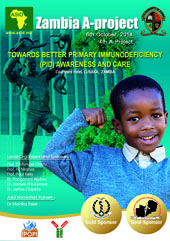 Dr Maryam KALLEL-SELLAMI
Dr Maryam KALLEL-SELLAMI
Immunology Department, La Rabta Hospital, El Jabbari, 1007 Tunis. Tunisia.
Phone: +216 71 57 87 60
Fax: +216 71 56 49 83
Email:
Complement was discovered in late of the 19th century as a heat-labile component of normal plasma that augments the opsonization of bacteria by antibodies and allows antibodies to kill pathogens. This activity was said to ‘complement' the antibacterial activity of antibodies, hence the name. Although first discovered as an effector arm of the antibody response, complement can also be activated early in infection in the absence of antibodies (1,2). Indeed, it now seems clear that complement first evolved as part of the innate immune system, where it still plays an important role. The complement system is made up of a large number of distinct plasma proteins which are activated through a triggered-enzyme cascade. In such a cascade, an active complement component activates another complement component by the same mechanisms (3). There are three distinct pathways through which complement can be activated: the classical, the alternative and the the Mannan-Binding Lectin (MBL) pathways. All depend on different molecules for their initiation, but they converge to a unique pathway called the terminal complement pathway that leads to membrane attack complex (MAC). The MBL pathway is initiated by binding of MBL, a serum protein, to mannose-containing carbohydrates on bacteria. The alternative pathway can be initiated when a spontaneously activated complement component binds to the surface of a pathogen. The classical pathway can be initiated by the binding of the first protein in the complement cascade, C1q, directly to antibodies in immun complexes. The essential steps of the classical and terminal pathways cascade are shown in schematic form in figure 1. In addition to direct killing of microbes through MAC formation, complement cooperates with other host defense mechanisms. Opsonisation with complement fragments (C3b, C4b) enhanced uptake by phagocytic cells via complement receptors. The solubility and clearance of immun complexes and the immunogenicity of antigens are also enhanced by complement fragments deposition. At the C3 and the C5 activation steps, cleavage products (the anaphylatoxins C3a and C5a) are generated, which set the stage for the inflammation and tissue injury (3).
The discovery of individuals with inherited complement deficiencies (ICD) has greatly contributed to understand the importance of the complement system in host defence and homeostasis. Bacterial infections, autoimmune and renal diseases are the clinical conditions most frequently associated with ICD. Other diseases observed in complement deficient patients include hereditary angioedema and paroxysmal nocturnal syndrome (4).
Almost all complement components deficiencies can predispose to infections. This mini-review will emphasize on the most frequent ICD: terminal components and properdin deficiencies predisposing to encapsulated extracellular bacteria (mainly Neisseria infections) and MBL deficiencies associated with a broad spectrum of microorganisms.
Inherited homozygous deficiencies of each of the terminal complement components (C5, C6, C7, C8, C9) are known to be associated with recurrent Neisseria meningitidis infections. They are transmitted as autosomal recessive deficiency with a relative risk factor of 6000. These deficiencies are rare in Caucasian populations with approximately 500 reported cases. The prevalence varies according to ethnic origin (e.g. C6 deficiency in Africans: 0,06%; C9 in Japanese: 1/1000). Patients with terminal components ICD are typically adolescents or young adults who suffer from recurrent meningococcal infections often caused by rare serogroups but rarely fatal. This was explained by the inability to generate a functionally active MAC thus a reduced extent of microbial damage and a less severe endotoxin shock (5).
Properdin is a positive regulator of the alternative pathway; it stabilizes the C3convertase and increases its life span. Properdin deficiency is inherited as an X-chromosomal recessive trait with more than 100 reported cases worldwide. Three types of properdin deficiency have been reported. Type I deficiency is the most common with complete absence of the protein. In Type II properdin concentration is diminished but functionally inactive and in type III, there is normal amount of properdin but it is functionally inactive. These deficiencies are associated with Neisseria meningitidis infections with a relative risk of 250 and a median age of 14 years. They are frequently complicated by sepsis and a higher mortality (30 to 75%) than late components deficiencies (5 to 7%). However recurrence of meningococcal infections is extremely rare. This may reflect the fact that protective antibodies are produced following infection and thus allow the activation of the classical pathway which is normal in this patients (6). Table 1 summarizes clinical and biological features of meningitidis associated with properdin deficiency and common terminal pathway deficiency compared to those of patients with a normal complement status.
Many studies have screened for common terminal pathway and properdin deficiencies in patients with septic or meningococcal infections and revealed frequencies ranging from 0 to 50% (reviewed in 7). Considering only studies performed on large cohorts, ICD were more prevalent in the Mediterranean regions such as Italy (17%) and were very rare in the European cohorts. High frequencies were reported in American patients and were related to high frequency of C6 deficiency in Afro-Americans. More recently, a study conducted by our group revealed a frequency of 12,3 % in a large population of 122 Tunisian adults presenting with septic meningitidis (8).
A more recently reported ICD predisposing to infection is MBL deficiency. MBL is the first component to be activated in the lectin pathway. The functionally active structure of MBL is made of a 3 to 6 repetition of a three polypeptides oligomer. MBL deficiency is due to polymorphisms in exon 1 of the MBL gene (MBL2) that affect oligomerization of the MBL monomers. The wild-type gene is termed “A” while the variant genes termed “B”, “C” and “D”, collectively referred to as “0” alleles, are associated to MBL deficiency (often defined as <100µg/L by ELISA). This autosomal codominant deficiency is prevalent in the general population: 10–15% of Caucasians carry MBL “0”alleles and 13% of African sub Saharian people (9). Since most individuals with MBL deficiency genotype are healthy, additional immunologic dysfunctions appear to be required for clinical manifestation such as physiological hypogammaglobulinemia, common variable immunodeficiency and immune depression after stem cell therapy or chemotherapy. In this population, MBL deficiency is a risk factor in particular for respiratory tract infections caused by a broad spectrum of microorganisms (9).
In practice, initial screening for ICD is based on (i) functional haemolytic assays including CH50 for the classical pathway and AP50 for the alternative pathway (ii) antigenic assays with measurement of C3 and C4 plasma levels. In the case of terminal components and properdin deficiencies, ICD are easily diagnosed as they are associated with undetectable functional activity in plasma (Table 1). Further measurements are needed to identify the deficient components such as supplementation assays with well characterized deficient plasmas and ELISA. Genetic analysis may be performed to confirm the presence of the mutation and to screen for the defect in related subjects. Diagnosis of a complement deficiency is important so that appropriate vaccination and prompt treatments of infections can be ensured. Genetic counseling can also be given and other potential treatments considered (10).
|
Table 1: Clinical and biological features of meningitidis associated with Properdin deficiency and Common terminal pathway deficiency compared to those of patients with a normal complement status
|
|||
|
Properdin deficiency |
Common terminal pathway deficiency |
General population |
|
|
Age of first episode (mean/years) |
14 |
17 |
2-3 |
|
Relative risk |
250 |
6000 |
1 |
|
Meningocoque Sérogroups |
Rare |
Rare |
B and C |
|
Mortality |
33-75% |
5-7% |
12,5% |
|
Recurrence |
Exceptional |
Frequent |
Exceptional |
|
Transmission |
X linked |
Autosomal recessive |
_ |
|
Complement investigations (N: normal) |
C3/C4: N CH50: N AP50: ↓↓ |
C3/C4: N CH50: ↓↓ AP50: ↓↓ |
C3/C4: N CH50: N AP50: N |

References
- Pillemer L, Blum L, Lepow IH. The properdin system and immunity. Demonstration and isolation of a new serum, properdin. Its role in human phenomena. Science. 1954:120(31112):279-85.
- Wolfgang MP, Reinhard W, Heribert S, Manfred PD. Complement. In Paul William. Fundamental immunology 5th ed. Lippincott. Williams E paul and wilkins; 2003.pp.1077-103.
- Waloport MJ. Complement first of two parts. N Engl J Med. 2001:344(14):1058-1066.
- Waloport MJ. Complement Second of two parts. N Engl J Med. 2001:344 (15): 1140-4.
- Skattum L,Van Deuren M, Van der Poll T, Lennart Truedsson L. Complement deficiency states and associated infections. Molecular Immunology.2011:48(14):1643–55.
- Rosain J, Ngo S, Bordereau P, Poulain N, Roncelin S, Vieira Martins P, Dragon Durey MA, Fremeaux Bacchi V. Complement deficiency and human diseases. Ann Biol Clin (Paris).2014:72(3):271-80.
- Kallel-Sellami M, Abdelmalek R, Zerzeri Y, Laadhar L, Blouin J, Zitouni M, Bacchi VF, Ben Chaabene T, Makni S. Complement protein hereditary deficits during purulent meningitis: study of 61 adult Tunisian patients. Arch Inst Pasteur Tunis. 2006:83(1-4):25-34.
- Abdelmalek R, Kallel Sallemi M, Zerzri Y, Kilani B, Laadhar L, Kanoun F, Tiouiri Benaissa H, Ghoubantini A, Ammari L, Makni S, Ben Chaabane T. Hereditary complement deficiency in Tunisian adults with purulent meningitis. Med Mal Infect. 2011: 41(4):206-8.
- Turner MW. The role of mannose-binding lectin in health and disease. Mol Immunol 2003; 40 (7):423-9.
- Botto M, Kirschfinkb M, Macorc P, Pickering, Würznerd R, Tedesco F. Complement in human diseases: Lessons from complement deficiencies. Molecular Immunology. 2009:46(14): 2774-83.



























